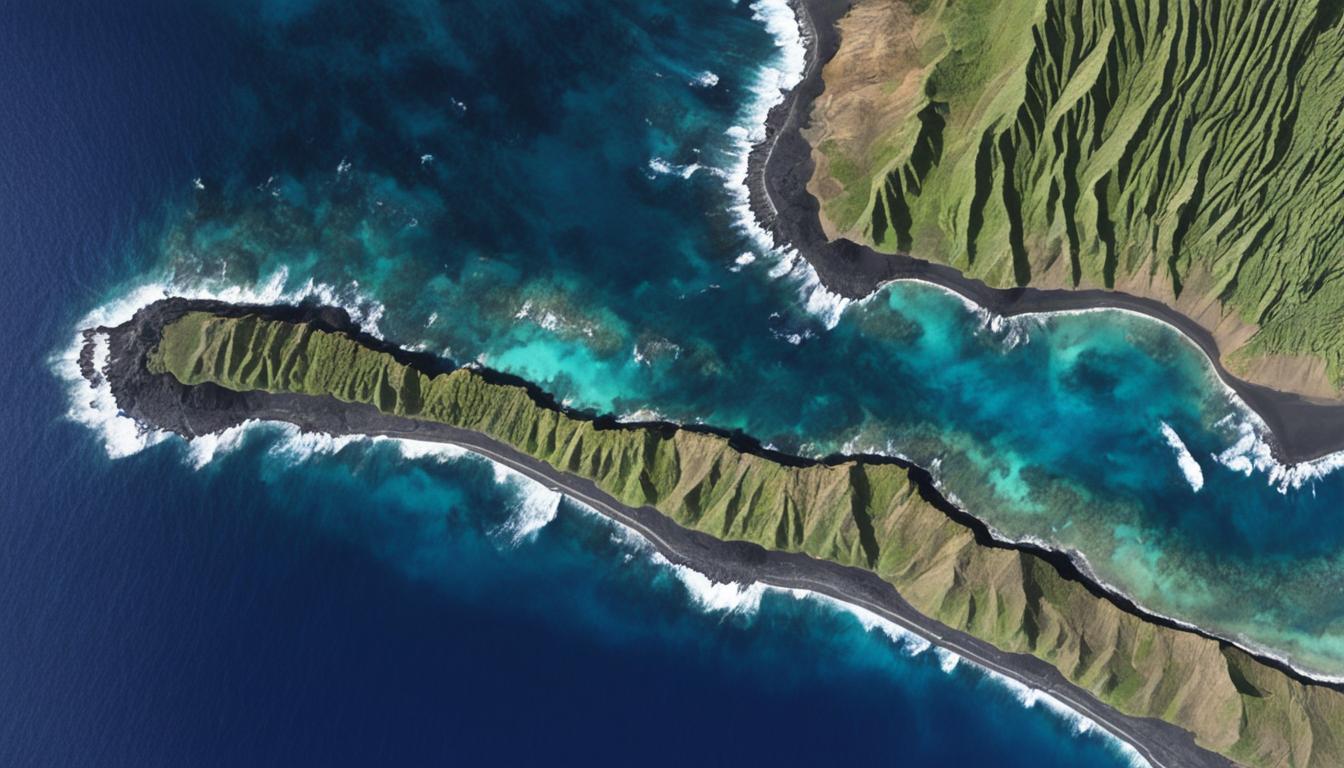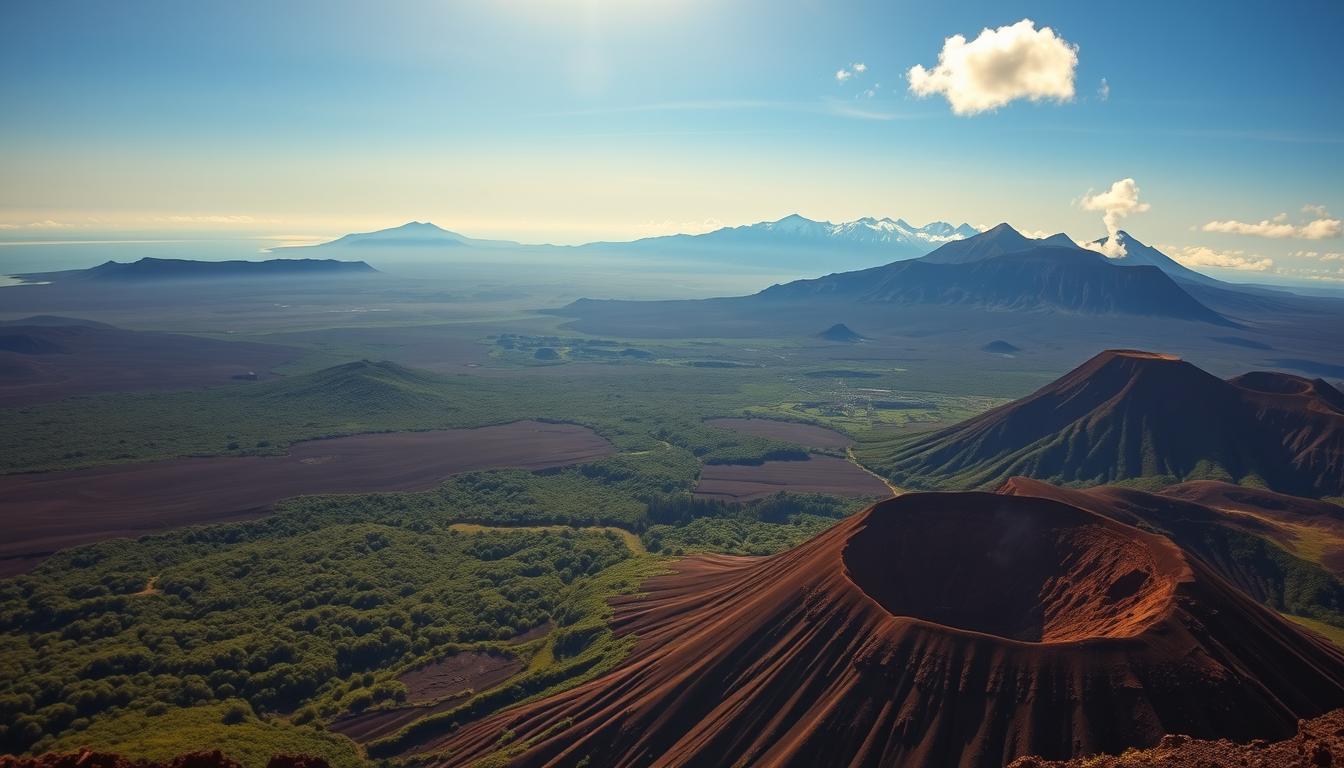Welcome to the breathtaking world of Google Earth, where you can embark on a virtual journey to explore the stunning landscapes and hidden gems of Hawaii. By harnessing the power of satellite imagery and advanced mapping technologies, Google Earth offers an immersive experience that allows you to discover the Aloha State like never before.
From the comfort of your own home, you can navigate through the lush valleys, soar above majestic volcanoes, and dive into the crystal-clear waters of Hawaii’s marine ecosystems. With just a few clicks, you’ll be transported to the heart of this tropical paradise, unlocking a wealth of knowledge about its rich cultural heritage, natural wonders, and captivating history.
Whether you’re an armchair traveler, a curious explorer, or an avid history enthusiast, Google Earth provides a unique platform to delve into the enchanting world of Hawaii. So, buckle up and get ready to embark on a virtual adventure like no other!
Key Takeaways:
- Google Earth offers a virtual journey to explore the stunning landscapes and hidden gems of Hawaii.
- Through satellite imagery and advanced mapping technologies, Google Earth provides an immersive experience.
- Discover the natural wonders, cultural heritage, and captivating history of Hawaii from the comfort of your own home.
- Navigate through lush valleys, soar above volcanoes, and dive into the crystal-clear waters of Hawaii’s marine ecosystems.
- Unlock a wealth of knowledge about Hawaii’s unique sites and embark on a virtual adventure like no other.
Exploring the Aloha State from Above: Virtual Tours on Google Earth
In our quest to uncover the hidden wonders of Hawaii, Google Earth proves to be an invaluable tool. Through its satellite imagery, this revolutionary platform offers a whole new perspective on the Aloha State. With just a few clicks, users can embark on virtual tours that showcase the diverse landscapes and rich cultural heritage of this tropical paradise.
How Google Earth’s Satellite Imagery Offers a New Perspective on Hawaii
Google Earth’s satellite imagery provides a bird’s-eye view of Hawaii, allowing users to explore the archipelago’s stunning landscapes from the comfort of their own homes. From the lush green valleys of Kauai to the mesmerizing turquoise waters of Maui, every corner of the Aloha State comes to life in intricate detail.
The high-resolution imagery captured by Google Earth’s satellites enables users to zoom in and examine the intricate features of the islands, such as volcanic craters, coastal cliffs, and dense forests. Whether you’re planning a future trip or simply curious about the natural beauty of Hawaii, Google Earth offers an immersive experience like no other.
The Evolution of Virtual Tourism in Hawaii Through Advanced Mapping Technologies
Virtual tourism has evolved significantly in recent years, thanks to advancements in mapping technologies like Google Earth. Through the integration of 3D models, Street View, and historical imagery, users can now explore Hawaii’s past and present with unprecedented realism.
Google Earth allows users to compare historical imagery with the present, unveiling the changes that have occurred over time. Witness the transformation of coastal areas, the growth of urban centers, and the impact of natural forces on the Hawaiian landscape. These interactive features give users a deeper understanding of the dynamic nature of the Aloha State.
Furthermore, with the integration of Street View, users can virtually walk through iconic Hawaiian streets, exploring local neighborhoods and landmarks. Whether you’re strolling along the vibrant streets of Waikiki or exploring the historic sites of Honolulu, Google Earth brings Hawaii’s urban environments to life.
Unearthing Hawaii’s Hidden Gems with Google Earth
Google Earth is not just a tool for exploring well-known tourist attractions in Hawaii; it also allows users to unearth hidden gems that often go unnoticed. With its advanced satellite imagery and mapping technologies, Google Earth provides a unique and immersive experience, taking virtual travelers off the beaten path and into the heart of Hawaii’s lesser-known treasures.
Whether you’re an adventurous explorer or a curious history enthusiast, Google Earth offers a wealth of opportunities to discover the hidden wonders of Hawaii. From secluded beaches to secret hiking trails and hidden waterfalls, you can navigate through the lush landscapes and uncover breathtaking natural beauty that may have previously remained undiscovered.
But it’s not just Hawaii’s natural beauty that can be explored through Google Earth. The platform also showcases the rich cultural heritage of the islands, allowing users to virtually visit ancient temples, archaeological sites, and significant landmarks. Through the detailed satellite imagery, you can delve into Hawaii’s past and gain a deeper understanding of its indigenous culture and historical significance.
One of the advantages of using Google Earth is the ability to zoom in and explore these hidden gems from a bird’s-eye view. By navigating through the interactive maps, you can plan your virtual journey, trace the paths less traveled, and gain new insights into Hawaii’s diverse landscapes.
So, whether you’re planning a future trip or simply want to satisfy your wanderlust from the comfort of your own home, Google Earth is the key to unearthing Hawaii’s hidden gems. Start your virtual adventure and embark on a journey through the captivating landscapes and cultural history of the Aloha State.
| Hidden Gems | Description |
|---|---|
| Hānauma Bay | Discover this stunning marine sanctuary, known for its vibrant coral reefs. Zoom in to explore the incredible underwater world. |
| Papakōlea Beach (Green Sand Beach) | Visit this unique beach with its distinctive olive-green sand, located near South Point on the Big Island. |
| Waipio Valley | Explore this lush valley, often referred to as the “Valley of the Kings,” known for its dramatic landscapes and scenic waterfall. |
| Waimoku Falls | Discover this hidden gem on the Road to Hana, where a towering waterfall cascades down the cliffs of Haleakalā National Park. |
Unique Hawaii Sites on Google Earth: A Journey to Unexplored Territories
Embark on a virtual adventure unlike any other as we take you on a journey to discover the unique sites of Hawaii on Google Earth. With advanced mapping technologies and satellite imagery, Google Earth offers unparalleled access to remote landscapes and natural wonders that may otherwise be inaccessible to the average traveler. In this section, we will explore the breathtaking beauty of Hawaii’s remote landscapes and delve into the spiritual significance of its sacred sites.
Reaching the Inaccessible: Discovering Hawaii’s Remote Landscapes
In the vast expanse of Hawaii’s natural landscapes, there are hidden treasures waiting to be uncovered. With Google Earth, you can explore the remote corners of the islands, from the rugged cliffs of the Napali Coast to the picturesque valleys of Haleakala. Immerse yourself in the stunning beauty of inaccessible landscapes, where towering waterfalls cascade into untouched pools, and lush forests stretch as far as the eye can see. Each virtual journey offers a unique perspective on Hawaii’s diverse ecosystems and highlights the awe-inspiring power of nature.
Using Google Earth’s satellite imagery, you can zoom in and explore the intricate details of these remote landscapes. Traverse the winding trails that lead to hidden viewpoints and marvel at the panoramic vistas that unfold before your eyes. Whether you’re a nature enthusiast or simply seeking a moment of tranquility, Google Earth allows you to escape to these remote landscapes from the comfort of your own home.
A Virtual Adventure: Experiencing Natural Wonders & Sacred Sites
Hawaii is home to a rich cultural heritage, with sacred sites that hold profound spiritual significance. Through Google Earth, you can embark on a virtual adventure to explore these culturally significant locations. From the sacred summit of Mauna Kea to the ancient temples of the Pu’uhonua o Honaunau National Historical Park, these sites offer a glimpse into the deeply rooted traditions of the Hawaiian people.
Immerse yourself in the stories and legends that surround these sacred sites as you navigate through virtual tours, gaining a deeper understanding of Hawaii’s cultural heritage. Experience the power of these spiritual landscapes and appreciate the reverence they hold for the Hawaiian community. Google Earth provides a platform for cultural preservation, allowing these sacred sites to be appreciated and understood by people from all around the world.
| Unique Hawaii Sites | Location | Description |
|---|---|---|
| Na Pali Coast | Kauai | A dramatic coastline featuring towering cliffs, hidden beaches, and lush valleys. |
| Haleakala National Park | Maui | Home to the world’s largest dormant volcano and diverse ecosystems. |
| Mauna Kea | Big Island | A sacred summit recognized as one of the best sites for astronomical observations. |
| Pu’uhonua o Honaunau National Historical Park | Big Island | An ancient place of refuge and a significant cultural site. |
Hawaiian Heritage Revealed: Historical Landmarks Visible on Google Earth
Immerse yourself in the rich history of Hawaii as you explore its remarkable historical landmarks using the powerful tool of Google Earth. From ancient temples to colonial buildings, these sites offer a fascinating glimpse into the vibrant culture and heritage of the Hawaiian Islands.
With Google Earth’s satellite imagery, you can get a bird’s eye view of these historical landmarks, allowing you to appreciate their architectural brilliance and significance. Zoom in to see intricate details and patterns, and gain a deeper understanding of the stories and traditions connected to each site.
To enhance your exploration, here are six SEO relevant historical landmarks in Hawaii that you can discover on Google Earth:
- Pu’uhonua o Honaunau National Historical Park: Experience the sacredness of this ancient place of refuge and learn about the traditional Hawaiian legal system.
- ‘Iolani Palace: Explore the only royal palace in the United States and admire its grandeur as the former residence of Hawaiian monarchs.
- Bishop Museum: Dive into Hawaii’s history and culture at this renowned museum, which houses extensive collections of artifacts and exhibits.
- Pearl Harbor: Witness a pivotal moment in history as you view the memorials and remnants of the attack on Pearl Harbor.
- Mo’okini Heiau: Discover the ancient temple dedicated to the war god Kū and marvel at its massive stone walls that have stood for centuries.
- Haleakalā National Park: Witness the breathtaking sunrise over Haleakalā crater, a place of spiritual and cultural significance for Hawaiians.
Through Google Earth, these historical landmarks come to life, providing a virtual journey through time and allowing you to appreciate the rich tapestry of Hawaii’s heritage. Whether you’re a history enthusiast or someone curious about the island’s past, these sites offer an opportunity to explore and learn.
So, embark on a digital exploration of Hawaii’s historical landmarks on Google Earth and unlock the secrets of the past. Let the captivating beauty and storied past of these sites transport you to a different era, all from the comfort of your own home.
Navigating Hawaii’s Lavish Landscapes from Your Living Room
Thanks to the incredible imagery and mapping technology of Google Earth, you can now explore and navigate the breathtaking landscapes of Hawaii without leaving the comfort of your own home. From lush rainforests to towering volcanoes, the virtual world allows you to uncover the hidden wonders of the Aloha State with just a few clicks.
Zooming in on Hawaii’s Diverse Ecosystems and Biomes
One of the most remarkable features of Hawaii is its diverse range of ecosystems and biomes. With Google Earth, you can zoom in and observe the distinct environments that make up the islands. From the vibrant coral reefs teeming with marine life to the dense forests filled with unique plant species, you can witness the intricate balance of nature from a bird’s eye view.
Explore the stunning beaches and crystal-clear waters that surround the islands, or venture into the lush valleys and mountain ranges that are home to rare and endangered species. Google Earth allows you to navigate through these ecosystems and learn more about the delicate harmony that exists within Hawaii’s natural habitats.
Nameless Beauties: Identifying Unknown Natural Features
In addition to the well-known landmarks and popular tourist destinations, Google Earth also reveals the hidden gems and nameless beauties scattered throughout Hawaii. As you explore the virtual landscape, you may come across breathtaking waterfalls, secluded beaches, or hidden caves that have yet to be discovered or named.
With the help of Google Earth’s satellite imagery, you can become an explorer and contribute to the identification and documentation of these unknown natural features. By tagging and sharing these findings, you can play a part in uncovering the mysteries of Hawaii’s enchanting landscapes.
Archaeological Marvels of Hawaii through Google Earth’s Lens
From Ahupua’a Boundaries to Royal Grounds: Charting the Historical Sites
Google Earth’s powerful satellite imagery and advanced mapping technologies have opened up unprecedented opportunities for archaeologists to unravel Hawaii’s rich cultural history. By utilizing Google Earth, researchers can now chart and explore the intricate boundaries of ancient ahupua’as, discover royal grounds, and delve into the fascinating remnants of ancient Hawaiian civilizations.
Piecing Together the Past: How Google Earth Aids Archaeologists in Hawaii
With Google Earth, archaeologists can virtually explore and analyze archaeological sites without the need for physical presence. By combining satellite imagery, historical maps, and geospatial data, researchers can reconstruct ancient landscapes, identify potential excavation sites, and conduct detailed analyses of artifact distributions.
Moreover, Google Earth’s advanced imagery technology enables archaeologists to visualize the evolution of sites over time, allowing them to track changes in land use and understand the impact of human activities on the landscape. This invaluable tool has revolutionized archaeological research in Hawaii, providing a new lens through which the past can be understood and interpreted.
| Benefits of Using Google Earth in Archaeological Research | Challenges and Limitations |
|---|---|
|
|
Virtual Hikes and Trails: Exploring Hawaii’s Terrain Digitally
In addition to uncovering its historical landmarks and natural wonders, Google Earth allows you to embark on virtual hikes and trails, revealing the diverse terrain that Hawaii has to offer. Through the power of satellite imagery and advanced mapping technologies, you can now explore the lush valleys, towering mountains, and stunning coastlines of the Aloha State from the comfort of your own home.
Immerse yourself in the beauty of Hawaii’s landscapes as you virtually traverse its renowned hiking trails. Witness the picturesque views from the world-famous Kalalau Trail on the Na Pali Coast of Kauai or feel the exhilaration of conquering the challenging switchbacks of the Haleakala Crater on Maui. With Google Earth, you can experience the thrill of these iconic hikes with just a few clicks.
Don’t miss the opportunity to discover hidden trails and lesser-known paths that are off the beaten track. Unearth the secrets of the Waihee Ridge Trail on Maui, known for its breathtaking panoramic views, or meander through the mystical bamboo forests of the Pipiwai Trail in Hana. Google Earth allows you to navigate through these enchanting locations, providing a virtual connection to the serene and untouched beauty of Hawaii’s landscapes.
Enhancing your virtual hiking experience, Google Earth also offers valuable information such as trail lengths, difficulty levels, and user reviews. Whether you’re a seasoned hiker seeking a new adventure or a beginner looking for a taste of Hawaii’s outdoor wonders, Google Earth’s virtual hikes and trails feature provides a convenient and immersive way to explore the diverse terrain of the islands.
Experience the magic of Hawaii’s landscapes without leaving your home. Let Google Earth be your guide as you embark on virtual hikes and trails through the breathtaking terrain that awaits you.
Hawaii’s Natural Monuments and Their Stories on Google Earth
Google Earth offers a fascinating glimpse into the natural wonders of Hawaii. Through advanced satellite imagery, users can explore the diverse landscapes, uncover ancient symbols, and interpret the cultural significance of the land. In this section, we will delve into the intriguing stories behind Hawaii’s natural monuments that can be discovered on Google Earth.
Decoding Geoglyphs: Delving into Ancient Hawaiian Symbols from the Sky
Hawaii is home to a rich history and ancient traditions. One intriguing aspect of Hawaiian culture is the presence of geoglyphs – large-scale symbols etched into the ground. These geoglyphs often represent spiritual and cultural beliefs, serving as significant markers of Hawaiian heritage. With Google Earth’s detailed satellite imagery, researchers and enthusiasts can unravel the meanings behind these enigmatic symbols, offering valuable insights into the ancient Hawaiian civilization.
Cultural Tales Told Through Land: Interpreting Natural Structures and Sites
Immerse yourself in the captivating stories of Hawaii’s natural structures and sites. From majestic waterfalls to volcanic formations, each geological wonder holds a unique narrative that reflects the island’s cultural heritage. With Google Earth, users can explore these sites from a bird’s-eye view, gaining a deeper understanding of their origins, cultural significance, and the legends associated with them. Whether it’s the breathtaking cliffs of the Na Pali Coast or the mystical Haleakalā Crater, Hawaii’s natural monuments come alive on Google Earth, inviting virtual adventurers to embark on a journey of discovery.
The wonders of Hawaii’s natural monuments await exploration on Google Earth. Uncover the hidden stories behind geoglyphs and delve into the cultural significance of the land. Through virtual exploration, users can gain a new perspective on Hawaii’s history and heritage, all from the comfort of their own homes.
The Enigma of Hawai’i’s Landscape: Mysteries Solved by Google Earth
Google Earth has revolutionized our understanding of the world, allowing us to explore distant lands and uncover hidden secrets without leaving the comfort of our homes. In the case of Hawai’i, this innovative technology has played a crucial role in solving the mysteries that shroud its captivating landscape.
One of the enigmas that have puzzled researchers for years is the formation of the Hawaiian Islands. Through the use of satellite imagery and advanced mapping tools, Google Earth has shed light on the geological processes that shaped these volcanic islands over millions of years. By examining the underwater topography and visualizing the volcanic features, scientists have gained valuable insights into the formation and evolution of this unique archipelago.
Furthermore, Google Earth has helped uncover hidden archaeological sites that were previously unknown to the world. The ability to zoom in on specific locations and examine ancient structures and artifacts with great detail has allowed archaeologists to make groundbreaking discoveries. From the remnants of ancient temples to mysterious petroglyphs etched into the rocks, these findings provide valuable insights into the rich history and culture of the Hawaiian people.
Another puzzle that Google Earth has helped solve is the phenomenon of “lava tubes” in Hawai’i. These natural underground tunnels formed by flowing lava have long intrigued scientists and adventurers alike. With the aid of satellite imagery, researchers have been able to locate and map these lava tubes, providing valuable information about their extent and connectivity. This knowledge has not only furthered our understanding of volcanic activity but also contributed to public safety by identifying potential hazards and areas at risk.
Overall, Google Earth has transformed the way we explore and comprehend the mysteries of Hawai’i’s landscape. By using its powerful satellite imagery and advanced mapping capabilities, we have been able to unravel the secrets of the islands’ formation, uncover hidden archaeological sites, and gain insights into volcanic processes. As we continue to delve into the enigma of Hawai’i’s landscape, Google Earth will undoubtedly remain an invaluable tool for researchers, adventurers, and anyone captivated by the beauty and intrigue of the Aloha State.
Visiting Hawaii’s Iconic Volcanoes with 360-Degree Google Earth Views
Virtual Lava Fields and Calderas: An Immersive Geological Experience
Immerse yourself in the awe-inspiring world of Hawaii’s iconic volcanoes from the comfort of your own home with Google Earth’s 360-degree views. Witness the raw power of these majestic features as you explore virtual lava fields and calderas, providing an unparalleled geological experience.
Google Earth’s advanced satellite imagery captures the dramatic landscapes surrounding Hawaii’s volcanoes, allowing you to navigate their rugged terrains with a few clicks. Trace the paths of ancient lava flows and imagine the sheer intensity of volcanic eruptions that shaped these remarkable landforms over millions of years.
The immersive nature of Google Earth’s 360-degree views enables you to virtually stand on the edge of lava fields and gaze into expansive calderas. Take in the breathtaking panoramic vistas, taking note of the unique geological features that make each volcano distinct.
Explore famous volcanoes such as Mauna Loa, one of Earth’s most massive and active shield volcanoes, and Kilauea, known for its ongoing eruptions and captivating lava lake. Study the intricate details of their topography and witness the impact of eruptions on surrounding landscapes.
Pele’s Domain: Virtual Homage to the Hawaiian Goddess of Volcanoes
In Hawaiian mythology, Pele is the goddess of volcanoes and embodies the fiery power of these natural wonders. Through Google Earth, pay homage to Pele and gain a deeper understanding of the sacred significance of volcanoes in Hawaiian culture.
As you explore the virtual landscapes, discover the legends and stories associated with each volcano. Uncover the rich cultural heritage ingrained in the land and learn about the deep spiritual connections between the Hawaiian people and these volcanic marvels.
Google Earth’s 360-degree views offer a unique opportunity to appreciate the beauty and power of Hawaii’s iconic volcanoes. Experience the geological wonders and cultural significance of these awe-inspiring sites, all with just a few clicks.
Wonders of Hawaiian Waters: Marine Sites Discerned by Google Earth
Unknown Reefs and Underwater Offshoots Explored from Above
Google Earth’s satellite imagery not only provides a captivating view of Hawaii’s terrestrial landscapes but also offers a unique perspective on the hidden wonders beneath the ocean’s surface. With the help of advanced mapping technologies, Google Earth reveals unknown reefs and underwater offshoots that are otherwise inaccessible to most people.
Google Earth as an Educational Tool for Understanding Hawaiian Marine Biology
Beyond the awe-inspiring visual experience, Google Earth serves as an invaluable educational tool for marine biology enthusiasts. By exploring the marine sites discerned by Google Earth, users can gain a deeper understanding of the diverse ecosystems and species that inhabit Hawaii’s waters. From coral reefs to marine sanctuaries, this interactive platform allows individuals to virtually immerse themselves in the vibrant marine life of the Aloha State.
Art Meets Technology: Discovering Hawaii’s Earthly Masterpieces
In addition to its breathtaking natural wonders, Hawaii is also home to a vibrant art scene that embraces the fusion of creativity and nature. Through the lens of satellite imagery, captivating art installations are revealed, uncovering the connection between human ingenuity and the beautiful Hawaiian landscape.
“Desert Breath” and Other Art Installations Captured Through Satellite Imagery
One remarkable example of this artistic synergy is the “Desert Breath” installation in the Egyptian Desert, which shares thematic similarities to the land art found in Hawaii. By employing satellite imagery, viewers can witness the massive spiral created by the artists Danae Stratou, Alexandra Stratou, and Stella Constantinides. This thought-provoking piece evokes contemplation on the relationship between humans and the environment. Similarly, Hawaii’s land art installations can be seen on Google Earth, enabling virtual exploration and appreciation of these impressive creations.
The Fusion of Creativity and Nature in Hawaiian Land Art
Hawaiian land artists draw inspiration from the natural surroundings, using materials found in the environment to create their masterpieces. From intricate rock formations to harmonious arrangements of flora, these art installations harmonize with the landscape and celebrate the unique essence of Hawaii. With satellite imagery, viewers can virtually traverse the island chain, discovering hidden treasures that merge artistic expression and the raw beauty of nature.
Advanced Virtual Cartography: Mapping Ancient Hawai’i on Google Earth
In addition to uncovering Hawaii’s hidden gems and natural wonders, Google Earth’s advanced virtual cartography allows users to delve into the rich history and ancient landscapes of the Hawaiian Islands. By combining satellite imagery, historical data, and archaeological research, Google Earth provides an immersive experience that brings the past to life.
Through the ancient cartographic maps and aerial images available on Google Earth, users can explore the remnants of ancient Hawaiian settlements, sacred sites, and cultural landmarks. These virtual maps offer a unique perspective on the historical locations, enabling users to visualize and comprehend the scale and layout of these ancient spaces.
One such example is the Pu’uhonua o Hōnaunau National Historical Park on the Big Island. With Google Earth, users can virtually walk through the sacred grounds and witness the preserved ancient structures, such as the Great Wall and the Place of Refuge. This digital exploration provides remarkable insights into the cultural practices and societal structures of the time.
Google Earth’s mapping capabilities also allow for the comparison and analysis of different archaeological sites across the Hawaiian Islands. By overlaying historic maps and satellite images, researchers and enthusiasts can identify patterns in settlement locations, land divisions, and ceremonial sites. This analysis contributes to a better understanding of the ancient Hawaiian culture and its connection to the land.
To enhance the virtual cartography experience, Google Earth partners with local cultural organizations and archaeological experts to provide detailed information and narratives about the ancient sites. These collaborations ensure that the historical context and significance of each location are accurately portrayed, offering users a comprehensive exploration of ancient Hawai’i.
| Benefits of Advanced Virtual Cartography on Google Earth | Impact on Understanding Ancient Hawai’i |
|---|---|
| 1. Access to historical maps and aerial imagery | 1. Visualize and comprehend ancient landscapes |
| 2. Comparison and analysis of archaeological sites | 2. Identify patterns in settlement locations and land divisions |
| 3. Collaboration with local cultural organizations | 3. Accurate portrayal of historical context and significance |
By utilizing advanced virtual cartography, Google Earth provides a valuable tool for researchers, educators, and enthusiasts to explore and learn about the rich cultural heritage of ancient Hawai’i. The integration of satellite imagery, archaeological data, and historical maps creates an immersive experience that fosters a deeper appreciation for the island’s past.
Unveiling the Military History of Oahu Defense Area via Google Earth
As we delve deeper into the rich history of Hawaii, we cannot overlook its military significance. Oahu, the most populous island of Hawaii, has played a crucial role in the defense of the United States. Through the power of Google Earth, we can uncover the hidden secrets of the Oahu Defense Area, a testament to the island’s military past.
Cold War Remnants in Tropical Paradise: Inspecting Abandoned Launch Sites
The Cold War era left its mark on Oahu, with various missile launch sites scattered throughout the island. Thanks to satellite imagery on Google Earth, we can explore these abandoned remnants from the comfort of our screens. Witness the concrete bunkers, launch pads, and other structures that once held the key to national security. The imagery offers a glimpse into the strategic prowess of the United States during a tumultuous era.
The Transformation of Strategic Points into Historical Landscapes
Over time, many of the former military sites on Oahu have been repurposed, transforming into historical landmarks that tell the story of Hawaii’s past. Google Earth provides a virtual tour of these transformed locations, allowing us to appreciate their historical significance and the memorialization efforts undertaken to honor the sacrifices made by those who served.
With Google Earth as our guide, we can navigate the Oahu Defense Area and gain a deeper understanding of its military history. From abandoned launch sites to repurposed landmarks, the visual journey through time showcases the enduring legacy of Oahu’s strategic importance.
From Phantom Islands to Intriguing Formations: The Puzzles of Hawaii on Google Earth
As we explore the stunning landscapes of Hawaii on Google Earth, we uncover a myriad of intriguing formations and hidden gems that have captivated the human imagination for centuries. From the enigmatic phantom islands to the awe-inspiring natural wonders, the Aloha State presents a tapestry of mysteries waiting to be unraveled.
One of the most fascinating puzzles on Google Earth are the phantom islands, mythical land masses that have been reported but never found. These elusive formations, such as the legendary Hawaiian island of “Ka’ūmoa” and the mysterious “Kanehe” Island, have remained undiscovered despite numerous attempts to locate them. Exploring these phantom islands on Google Earth allows us to delve into the allure of the unknown and ponder the untold stories they hold.
Another enigma presented by Hawaii’s unique topography is the presence of intriguing geological formations. From the mesmerizing sea arches at Makapuʻu Point to the astonishing Blowhole at Waimea Bay, these natural wonders leave us in awe of the forces of nature. With Google Earth’s high-resolution satellite imagery and 3D mapping technology, we can virtually stand on the precipice of these sites and witness the power and beauty of their creation.
Through the lens of Google Earth, we embark on a virtual quest to unravel the mysteries of Hawaii. From the phantom islands to the captivating formations, each discovery adds another layer of fascination to this Pacific paradise. Join us as we navigate the virtual terrain, uncovering the secrets that lie within the vibrant tapestry of Hawaii’s remarkable landscapes.
FAQ
How can I discover unique Hawaii sites on Google Earth?
You can discover unique Hawaii sites on Google Earth by utilizing its satellite imagery and advanced mapping technologies to explore hidden gems, historical landmarks, diverse ecosystems, archaeological marvels, natural monuments, iconic volcanoes, marine sites, earthly masterpieces, ancient Hawai’i, and the military history of Oahu Defense Area.
How does Google Earth’s satellite imagery offer a new perspective on Hawaii?
Google Earth’s satellite imagery offers a new perspective on Hawaii by providing an aerial view of the islands, allowing you to virtually explore and appreciate the beauty of the Aloha State from above. It enables you to zoom in on lavish landscapes, identify unknown natural features, chart historical sites, and even decode ancient Hawaiian symbols.
How has virtual tourism in Hawaii evolved through advanced mapping technologies?
Virtual tourism in Hawaii has evolved through advanced mapping technologies by offering virtual tours on Google Earth. These tours allow users to embark on a virtual adventure, experiencing natural wonders and sacred sites that may be inaccessible in reality. It provides an immersive and educational experience, showcasing the rich cultural heritage and diverse ecosystems of Hawaii.
How can I unearth Hawaii’s hidden gems with Google Earth?
You can unearth Hawaii’s hidden gems with Google Earth by using its satellite imagery and search functions. By exploring the islands digitally, you can discover lesser-known natural sites, off-the-beaten-path locations, and secret spots that are not widely publicized. It’s a great tool for adventurous explorers looking to discover Hawaii’s unexplored territories.
How can I reach inaccessible remote landscapes in Hawaii using Google Earth?
You can reach inaccessible remote landscapes in Hawaii using Google Earth’s satellite imagery. By zooming in on these remote areas, you can virtually explore and appreciate the untouched beauty of Hawaii’s natural landscapes, including rugged coastlines, dense forests, and majestic mountains that may be difficult or impossible to access physically.
How can Google Earth help me in identifying and understanding unknown natural features in Hawaii?
Google Earth can help you in identifying and understanding unknown natural features in Hawaii by providing detailed satellite imagery and location information. By zooming in on nameless beauties, you can learn more about these natural formations, such as waterfalls, forests, valleys, and other geological features. It’s an excellent tool for geographers, researchers, and nature enthusiasts.
How does Google Earth aid archaeologists in piecing together Hawaii’s past?
Google Earth aids archaeologists in piecing together Hawaii’s past by providing detailed maps, satellite imagery, and historical data. It allows archaeologists to digitally chart and preserve historical sites, including ahupua’a boundaries and royal grounds. By examining these sites from above, researchers can gain valuable insights into the ancient Hawaiian civilization.
How can I explore Hawaii’s trails and hikes digitally through Google Earth?
You can explore Hawaii’s trails and hikes digitally through Google Earth by utilizing its satellite imagery and 360-degree views. Google Earth allows you to virtually navigate through Hawaii’s diverse terrain, including lush forests, volcanic craters, and scenic coastal paths. It provides a unique opportunity to experience the beauty of Hawaii’s natural landscapes from the comfort of your home.
How does Google Earth reveal the stories of Hawaii’s natural monuments?
Google Earth reveals the stories of Hawaii’s natural monuments by providing detailed satellite imagery and information about these landmarks. By delving into geoglyphs and interpreting natural structures, you can gain a deeper understanding of the cultural significance and historical context of these monuments. It’s a fascinating way to explore Hawaii’s rich heritage.
What mysteries of Hawaii’s landscape can be solved using Google Earth?
Google Earth can help solve various mysteries of Hawaii’s landscape by providing detailed satellite imagery and historical data. From unraveling the secrets of phantom islands to exploring intriguing formations, it allows researchers and enthusiasts to uncover hidden geological, archaeological, and historical puzzles. It’s a powerful tool for unraveling the enigmas of Hawai’i.
How can I virtually visit Hawaii’s iconic volcanoes using Google Earth’s 360-degree views?
You can virtually visit Hawaii’s iconic volcanoes using Google Earth’s 360-degree views. By exploring virtual lava fields and calderas, you can immerse yourself in the fascinating geological wonders of these volcanoes. Additionally, you can pay virtual homage to Pele, the Hawaiian goddess of volcanoes, and experience the power and beauty of these natural phenomena.
How does Google Earth assist in understanding Hawaiian marine biology?
Google Earth acts as an educational tool for understanding Hawaiian marine biology by providing satellite imagery and information about coral reefs, marine ecosystems, and underwater offshoots. It allows users to explore and study these marine sites from above, gaining insights into the diverse marine life and ecological importance of Hawaiian waters.
How does Google Earth capture and showcase Hawaiian land art installations?
Google Earth captures and showcases Hawaiian land art installations by utilizing satellite imagery to capture these artistic masterpieces from above. It allows users to admire and appreciate the fusion of creativity and nature, highlighting installations like “Desert Breath” and other unique projects. It provides a platform for artists to share their work with a global audience.
How can Google Earth’s virtual cartography help in mapping ancient Hawai’i?
Google Earth’s virtual cartography helps in mapping ancient Hawai’i by providing detailed maps, historical data, and satellite imagery. By utilizing these resources, researchers and historians can create accurate digital representations of ancient Hawaiian landscapes, settlements, and architectural features. It’s an invaluable tool for studying and preserving Hawai’i’s rich cultural history.
How can Google Earth unveil the military history of the Oahu Defense Area?
Google Earth can unveil the military history of the Oahu Defense Area by providing satellite imagery and historical data. It allows users to inspect abandoned launch sites, underground bunkers, and other remnants of the Cold War era in this tropical paradise. It offers a unique perspective on how strategic points in Hawai’i have transformed into historical landscapes.
What are some of the puzzles of Hawaii that can be explored on Google Earth?
Google Earth allows users to explore and uncover some of the puzzles of Hawaii’s landscape. From unidentified formations to mysterious geological features, it provides a platform for researchers and enthusiasts to investigate and learn about these intriguing enigmas. It’s a fascinating adventure for those with a curiosity for the unknown.

Scott Sweeney is the creator of Virtual Hawaii 360. Scott is a professional marketer and a lifelong Hawaii enthusiast. Scott splits time between Oahu and Dayton, Ohio. In addition to his marketing endevours, he is also a published Ukulele musician.





